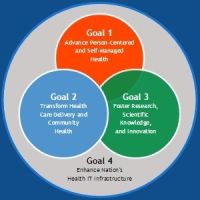While people often take for granted the convenience of being able to withdraw money from an ATM hundreds of miles from home or call someone in another cellphone network, that same sort of universal operability has yet to be achieved for the electronic exchange of patient information, according to an article in JAMA's Medical News & Perspectives section.
Use of electronic health records can help facilitate clinical decision-making and improve care coordination between providers. However, despite increasing popularity of EHRs — in 2013 48 percent of office-based physicians and 59 of hospitals used EHRs — information is still not being widely shared across institutions. This is because “EHRs are not yet sufficiently standardised to allow seamless interoperability,” stated a 2014 report from the Office of the National Coordinator for Health Information Technology (ONC).
Earlier this year, the ONC unveiled a draft of a 10-year interoperability road map, outlining steps needed to be taken in governance, technical standards, business and regulatory climate to ensure the secure and seamless flow of healthcare data among providers and consumers. With interoperability, information about a patient’s medications, diagnostic tests, allergies, or recent appointments can be pulled from an EHR or database at a physician’s office, hospital, or laboratory and folded into the patient’s EHR at another location.
Although the ONC road map presents the movement toward interoperability as a smooth, straight road, in reality it’s more like fitting together the pieces of a giant jigsaw puzzle, notes the JAMA article. Several public and private organisations are working on different pieces, including organisations creating technical standards, establishing health information exchange (HIE) networks, connecting those HIEs, and developing governance and usage protocols. The hope, according to health IT experts, is that all the pieces eventually will interlock.
For example, Health Level Seven International (HL7) — which establishes American National Standards Institute-accredited standards for electronic health information technology — is developing Fast Healthcare Interoperability Resources (FHIR), a technical standards framework that will simplify the process of exchanging data between EHR systems.
James Salwitz, MD, who practices with Regional Cancer Care Associates (with 26 offices across New Jersey), shared an example of the consequences of the lack of interoperability: when a patient came for an appointment, he noticed the patient had an enormous bruise on his face. It turned out that the patient had undergone eye surgery but had not told the surgeon that he was taking an anticoagulant, and the surgeon did not have access to this information because he could not access the patient’s EHR at another medical facility.
The ability of clinicians to share data electronically has become especially important because the Centers for Medicare & Medicaid Services’ newest draft regulations for stage 3 “meaningful use” of EHRs stipulate that clinicians must be able to exchange healthcare information through EHRs.
“Technology is almost never the obstacle [to interoperability],” noted John Kansky, CEO of the Indiana Heath Information Exchange (IHIE). “It is really the governance of the data and getting organisations with different agendas to agree on what you are going to do.”
Although interoperability has only come into the spotlight in the past few years, some organisations have been quietly exchanging data electronically for years. For example, the IHIE, which opened in 2004, connects 25,000 physicians, hospitals, and other healthcare providers in 17 states. Members pay yearly subscription fees, said Kansky. In 2005, EHR vendor Epic launched "Care Everywhere", a network that allows healthcare organisations and clinicians who use Epic software to exchange health information.
Source: JAMA
Image credit: Flickr.com
Use of electronic health records can help facilitate clinical decision-making and improve care coordination between providers. However, despite increasing popularity of EHRs — in 2013 48 percent of office-based physicians and 59 of hospitals used EHRs — information is still not being widely shared across institutions. This is because “EHRs are not yet sufficiently standardised to allow seamless interoperability,” stated a 2014 report from the Office of the National Coordinator for Health Information Technology (ONC).
Earlier this year, the ONC unveiled a draft of a 10-year interoperability road map, outlining steps needed to be taken in governance, technical standards, business and regulatory climate to ensure the secure and seamless flow of healthcare data among providers and consumers. With interoperability, information about a patient’s medications, diagnostic tests, allergies, or recent appointments can be pulled from an EHR or database at a physician’s office, hospital, or laboratory and folded into the patient’s EHR at another location.
Although the ONC road map presents the movement toward interoperability as a smooth, straight road, in reality it’s more like fitting together the pieces of a giant jigsaw puzzle, notes the JAMA article. Several public and private organisations are working on different pieces, including organisations creating technical standards, establishing health information exchange (HIE) networks, connecting those HIEs, and developing governance and usage protocols. The hope, according to health IT experts, is that all the pieces eventually will interlock.
For example, Health Level Seven International (HL7) — which establishes American National Standards Institute-accredited standards for electronic health information technology — is developing Fast Healthcare Interoperability Resources (FHIR), a technical standards framework that will simplify the process of exchanging data between EHR systems.
James Salwitz, MD, who practices with Regional Cancer Care Associates (with 26 offices across New Jersey), shared an example of the consequences of the lack of interoperability: when a patient came for an appointment, he noticed the patient had an enormous bruise on his face. It turned out that the patient had undergone eye surgery but had not told the surgeon that he was taking an anticoagulant, and the surgeon did not have access to this information because he could not access the patient’s EHR at another medical facility.
The ability of clinicians to share data electronically has become especially important because the Centers for Medicare & Medicaid Services’ newest draft regulations for stage 3 “meaningful use” of EHRs stipulate that clinicians must be able to exchange healthcare information through EHRs.
“Technology is almost never the obstacle [to interoperability],” noted John Kansky, CEO of the Indiana Heath Information Exchange (IHIE). “It is really the governance of the data and getting organisations with different agendas to agree on what you are going to do.”
Although interoperability has only come into the spotlight in the past few years, some organisations have been quietly exchanging data electronically for years. For example, the IHIE, which opened in 2004, connects 25,000 physicians, hospitals, and other healthcare providers in 17 states. Members pay yearly subscription fees, said Kansky. In 2005, EHR vendor Epic launched "Care Everywhere", a network that allows healthcare organisations and clinicians who use Epic software to exchange health information.
Source: JAMA
Image credit: Flickr.com
Latest Articles
healthmanagement, health IT, interoperability, EHR, data sharing, networks
While people often take for granted the convenience of being able to withdraw money from an ATM hundreds of miles from home or call someone in another cellphone network, that same sort of universal operability has yet to be achieved for the electronic exc



























